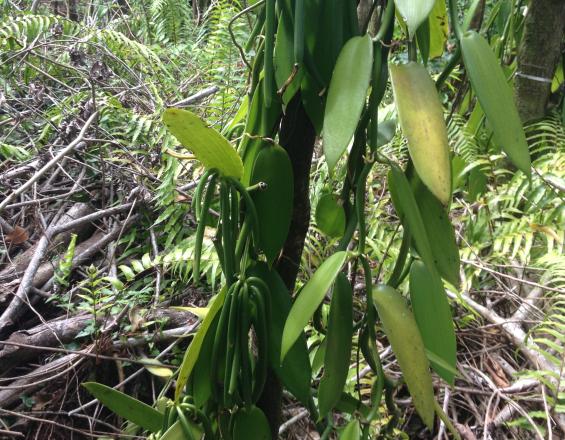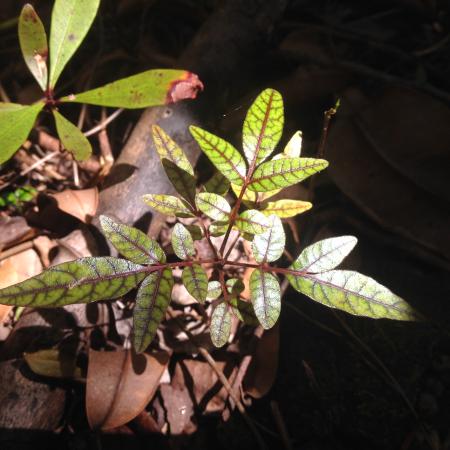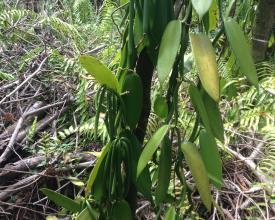
Involving vanilla growers in the conservation of tropical forest biodiversity

The ONF (National Forestry Commission) has involved Vanilla growers (over 200 in St Philippe) in the ecological restoration of some of the most overgrown plots of forest in the Biological Reserve, by granting them concessions. The concessionaires have carried out extensive work to control invasive plants (in particular Schinus and Psidium), while retaining native trees to act as stakes for the Vanilla. Other native species have also been preserved, and the disappearance of invasive species has encouraged their return to the undergrowth (ferns in particular). In these conceded plots, native species once again dominate the forest canopy, while allowing Vanilla production in the undergrowth. The undergrowth is maintained by the concession holder, in accordance with a set of specifications, and monitored by ONF agents. This system helps to control invasive species such as Clidemia hirta and limit their invasion of the neighboring, well-preserved relics.
Context
Challenges addressed
The main challenge is to reconcile the conservation of biodiversity and native forests with social and economic development.
In some areas, vanilla cultivation can contribute to biodiversity conservation objectives, provided it is well managed and controlled.
It is also important that protected areas provide income for local populations, to encourage their long-term acceptance and enable conservation objectives to be pursued.
Location
Process
Summary of the process
Stage 1: management plan
- Determines the areas of Vanilla cultivation compatible with the reserve's conservation objectives (invaded anthropized areas on the periphery of well-preserved primary forests).
- Leads to the issuing of a ministerial decree creating the reserve, which authorizes Vanilla cultivation in the reserve, if it contributes to the conservation objectives and applies specific specifications.
Stage 2: Concession contract and specific specifications
- Vanilla concessionaires in the reserve sign a concession contract with the ONF (for 9 years, renewable), clearly indicating in specific specifications what is and what is not authorized (e.g. destruction of a native species).
Stage 3: monitoring and control
Regular checks ensure compliance with the contract's specifications. Ecological monitoring ensures the positive effect on native species and helps to determine the set of measures that can be beneficial to biodiversity in these conceded areas.
Building Blocks
management plan for the biological reserve
The primary objective of the Biological Reserve planning document is to conserve biodiversity. To draw up this management plan, specific work was carried out on existing vanilla concessions and in areas where new concessions would contribute to the RB's conservation objectives. Areas of high naturalness were excluded to ensure their conservation and the implementation of diffuse control actions.
Enabling factors
Commitment of all stakeholders to this approach
On-site inventory
Meeting with vanilla growers and gathering their expectations and practices
Lesson learned
The management plan for the protected area, which also serves as the creation dossier, has from the outset incorporated the development of vanilla as an income-generating activity, contributing to the conservation of biodiversity. The time invested in drawing up the management plan, with the participation/integration of all stakeholders, is long but necessary for its success.
The protected area (biological reserve) was then created by ministerial decree (signed by the Ministry of the Environment and the Ministry of Agriculture):"to achieve the conservation objectives of the reserve, the exploitation of Vanilla concessions is authorized in accordance with specific specifications" (article 6 of the AM).
A concession contract is signed by the growers, requiring them to comply strictly with the specifications set out in the contract. They are then regularly inspected by the forestry officer, who ensures compliance with the specifications.
specifications and concession contract
The concession contract regulates the cultivation of vanilla undergrowth in Réunion's public forests. In particular, it prohibits all cutting of native species and only authorizes the elimination of invasive exotic species. In addition, in the biological reserve, concessionaires have been given specific terms and conditions to ensure that they contribute to biodiversity conservation. All Vanille concessionaires were brought together (in the field) to remind them of the issues at stake in the reserve, their important role and the need for them to preserve native species (whether woody species, ferns or orchids, on the ground or as epiphytes on trees). They were given a one-day training course on recognizing the native and exotic species present in the RB and more specifically in their concessions (which they were already very familiar with, having worked in this type of forest for many years).
Enabling factors
The contract and the precise delimitation of the concession are essential to frame the activity and then to be able to control it.
The Vanille concession contract is granted by the ONF for a period of 9 years, renewable if the terms of the contract have been respected.
It can be terminated in the event of non-compliance (after several warnings by the ONF agent).
NB: Until now, the ONF has been able to rely on the seriousness and commitment of the concessionaires present in the biological reserve.
Lesson learned
It's important to formalize in writing what is and isn't allowed.
The limits of concessions must be clear and well marked.
Formalism does not prevent direct dialogue with dealers: on the contrary, it is essential to encourage it.
Ecological monitoring
It is necessary to monitor the impact of invasive species control exercised by Vanille concessionaires on the return and maintenance of native species. A first follow-up was organized in 2014-2015 on a pilot plot. The next follow-up will be organized in 2020, with a review of the effect on all the concessions granted.
At the same time, forestry officers and the ONF land department keep concession maps up to date, noting for each concessionaire whether he or she is complying with the instructions, and if not, noting this in a specific register to ensure follow-up of the corrective measures requested of the concessionaires.
Enabling factors
Good botanical knowledge, good understanding of invasion processes and population dynamics.
Lesson learned
A more scientific study, in addition to the regular monitoring tours, has enabled us to assess the species richness and the resurgence of certain rare species. The study was also an opportunity to demonstrate to concession-holders ONF's particular attention to biodiversity enhancement in Vanille concessions.
Impacts
1. Better management and control of invasive plants in the reserve, particularly in less well-preserved areas where the manager does not have the financial means to take action;
2. Development of native plants, which are reintroducing themselves into the plots thanks to the operations to control invasive species. Some very rare endemic heliophilous species have also been able to regenerate following the elimination of Schinus terebenthifolius, which was forming a dense canopy in places.
3. Concession-holders happy to have found new, favorable land close to home (they previously owned concessions much further away), which provides them with a not inconsiderable income.
4. Economic development of the forest, while ensuring its conservation and rehabilitation in the most degraded areas.
This is particularly important in this commune, where the unemployment rate is over 30%.
5. Concessionaires to become ONF surveillance auxiliaries. No more acts of poaching observed (debarking of endangered medicinal species) in concession plots.
Beneficiaries
Biodiversity protected in the biological reserve
Inhabitants of Saint-Philippe (Vanilla cultivation concessionaires)
Vanilla, a high value-added product and traditional crop
Reunion's economy
ONF
Sustainable Development Goals
Story

Julien TRIOLO, head of ecology at ONF:
"The first time I saw a natural regeneration of Poupartia borbonica, a very rare endemic tree, in my 20-year career on Reunion Island, it was in one of the new concessions granted in the biological reserve. The seedlings appeared and were able to develop thanks to the elimination by the concessionaires of the Baie rose (Schinus terebenthifolius), an exotic species that dominated the forest cover."
https://la1ere.francetvinfo.fr/reunion/saint-philippe/saint-philippe-deux-nouvelles-reserves-biologiques-dediees-au-littoral-foret-bois-couleurs-866548.html
https://www.clicanoo.re/Societe/Article/2020/09/01/VIDEO-Saint-Philippe-protege-ses-richesses_614043
https://www.linfo.re/videos/toutes-nos-videos/inauguration-de-2-reserves-biologiques
